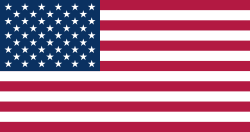United States of America | |
|---|---|
| Motto: "In God We Trust" Other traditional mottos:
| |
| Anthem: "The Star-Spangled Banner" | |
| Capital | Washington, D.C. 38°53′N 77°1′W / 38.883°N 77.017°W |
| Largest city | New York City 40°43′N 74°0′W / 40.717°N 74.000°W |
| Official languages | None at the federal level |
| National language | English |
| Ethnic groups (2020) | By race:
By origin:
|
| Religion (2023) |
|
| Demonym(s) | American |
| Government | Federal presidential republic |
| Donald Trump | |
| JD Vance | |
| Mike Johnson | |
| John Roberts | |
| Legislature | Congress |
| Senate | |
| House of Representatives | |
| Independence from Great Britain | |
| July 4, 1776 | |
| March 1, 1781 | |
| September 3, 1783 | |
| June 21, 1788 | |
| Area | |
Total area | 3,796,742 sq mi (9,833,520 km2) (3rd) |
Water (%) | 7.0 (2010) |
Land area | 3,531,905 sq mi (9,147,590 km2) (3rd) |
| Population | |
2024 estimate | |
2020 census | |
Density | 87/sq mi (33.6/km2) (185th) |
| GDP (PPP) | 2024 estimate |
Total | |
Per capita | |
| GDP (nominal) | 2024 estimate |
Total | |
Per capita | |
| Gini (2023) | medium inequality |
| HDI (2022) | very high (20th) |
| Currency | U.S. dollar ($) (USD) |
| Time zone | UTC−4 to −12, +10, +11 |
Summer (DST) | UTC−4 to −10 |
| Date format | mm/dd/yyyy |
| Calling code | +1 |
| ISO 3166 code | US |
| Internet TLD | .us |
Table of Contents
Introduction to Trademarks
A trademark is a distinctive sign, symbol, or expression that identifies and distinguishes the source of goods or services of one entity from those of others. In the business world, trademarks play a crucial role in protecting brand identities and fostering consumer trust. By legally safeguarding a trademark, a business can secure its reputation and market position, enabling it to build lasting relationships with its customers.
The primary purpose of trademarks is to prevent consumer confusion. When a customer sees a recognizable trademark, it signals that the product or service meets a certain quality standard and comes from a reputable source. This is particularly important in today’s competitive marketplace, where consumers are often inundated with choices. Without trademarks, businesses would struggle to build brand loyalty, and consumers would find it challenging to make informed purchasing decisions.
Additionally, failing to properly trademark intellectual property can have significant legal implications. Businesses that neglect to register their trademarks risk losing their exclusive rights to use the mark. This can lead to unauthorized use by competitors, dilution of brand identity, and potential legal disputes. Consequently, it is advisable for businesses to seek trademark registration as a proactive measure to protect their intellectual property.
Trademarks can be categorized into different types, each serving distinct functions and legal protections. Some common types include word marks, design marks, service marks, and collective marks, among others. Understanding these classifications is vital for businesses that wish to navigate the complexities of trademark law effectively. In the subsequent sections of this guide, we will delve into the various types of trademarks, exploring their unique features and legal considerations.
Word Marks: The Foundation of Branding
Word marks play a crucial role in trademark law and serve as the foundation of branding for many businesses. A word mark is a type of trademark that consists exclusively of words, letters, numbers, or any combination thereof, used to identify and distinguish the source of goods or services. The primary function of a word mark is to serve as a unique identifier, enabling consumers to recognize and associate a brand with specific products or services, thereby fostering brand loyalty.
When selecting a word mark, businesses must consider several criteria to ensure the effectiveness of their trademark. Firstly, the chosen mark must be distinctive, meaning it should not be generic or merely descriptive of the goods or services offered. The more unique the word mark, the stronger its protection under trademark law. Additionally, it is advisable to conduct a thorough search for existing trademarks to avoid potential conflicts and infringement issues. Moreover, a strong word mark should be easy to remember, pronounce, and spell, ensuring that customers can easily recall it in relation to the brand.
Once a suitable word mark has been selected, the next step is registration with the United States Patent and Trademark Office (USPTO). The registration process typically involves submitting an application that includes a description of the goods or services associated with the mark, the date of first use, and a specimen showing how the mark is used in commerce. It is important to follow the guidelines set forth by the USPTO to improve the likelihood of successful registration.
Word marks can represent a wide variety of products and services across numerous industries. Famous examples of word marks include “Nike,” which signifies athletic apparel and shoes, and “Coca-Cola,” a well-known beverage brand. These trademarks signify the significance of maintaining brand recognition and the value attached to protecting one’s intellectual property through effective word marks.
Design Marks: Protecting Visual Identity
Design marks play a crucial role in trademark protection by safeguarding the unique visual elements that represent a brand. Generally, a design mark comprises logos, symbols, or graphic representations that communicate the brand’s identity and create a lasting impression on consumers. Unlike word marks, which are composed solely of text, design marks can include stylized text alongside visual symbols, which makes them appealing in various marketing contexts.
To qualify as a design mark, the visual element must be distinctive and serve as a source identifier for the goods or services offered. Distinctiveness can either be inherent, derived from the unique design itself, or acquired through extensive use in the marketplace, thus allowing consumers to associate the design with a specific brand. For example, the iconic swoosh symbol of Nike is a design mark that is instantly recognizable and has become synonymous with athletic wear.
The process of registering a design mark involves submitting an application to the United States Patent and Trademark Office (USPTO). This application must include a clear representation of the design, along with a description of the goods or services it represents. Additionally, applicants must demonstrate that the design mark meets distinctiveness requirements. Legal considerations, such as potential conflicts with existing trademarks, play a significant role in the approval process. It is advisable for applicants to conduct a comprehensive search of existing trademarks before filing to avoid infringement issues.
Famous examples of design marks include the golden arches of McDonald’s and the apple logo of Apple Inc. These symbols have transcended their visual characteristics to embody the essence of their respective brands, highlighting the importance of design marks in protecting a company’s visual identity and ensuring brand recognition in an increasingly competitive marketplace.
Sound Marks: The Power of Audio Branding
Sound marks represent a distinctive category of trademarks that protect auditory elements associated with a brand. These trademarks are significant because they contribute substantially to the overall identity and marketing strategies of companies. The ability of sound to evoke emotion and create immediate recognition can establish a profound connection between a brand and its consumers. When people hear a particular sound, it can trigger memories or feelings associated with a specific product or service, facilitating brand loyalty and recognition.
For a sound to qualify as a trademark, it must meet specific criteria outlined by the United States Patent and Trademark Office (USPTO). The sound must be inherently distinctive or have acquired distinctiveness through extensive use in commerce. This means that the sound has to be unique or has become recognized by the public as being synonymous with the brand. Additionally, the sound should not be merely functional; it must resonate with the brand identity rather than serve a practical purpose.
Several iconic sound marks have successfully entered the public consciousness and become integral to their respective brands. For instance, the “tuning fork” sound of a well-known computer company instantly conjures images of their innovative products, while the distinctive jingle of a popular cereal brand is often associated with happy childhood memories. These examples illustrate the potent impact that sound marks can have on consumer perception and emotional branding.
In conclusion, sound marks play a vital role in modern branding strategies. By harnessing the power of audio branding, companies can deepen their connection with consumers and enhance brand recognition, thereby gaining a competitive edge in the marketplace. The effective use of sound as a trademark showcases the importance of sensory experiences in shaping consumer behavior and perceptions.
Color Marks: Protecting Brand Aesthetics
Color marks represent a unique category in the trademark system, where specific colors, or combinations of colors, can be owned by a brand to distinguish its goods or services from those of competitors. Unlike traditional trademarks, which often consist of words or logos, color marks rely solely on color as a form of brand identity. Some well-known examples include Tiffany & Co.’s signature robin egg blue and the bright pink used by Owens Corning. These brands have successfully navigated the legal landscape to secure protection for their distinctive colors, showcasing the potential impact of color on brand recognition.
However, registering a color mark poses several legal challenges. To obtain trademark protection, a company must prove that the color in question has acquired distinctiveness through extensive use in commerce, which can be a difficult standard to meet. Unlike other trademarks that are inherently distinctive, colors must demonstrate secondary meaning; this means that consumers associate the specific color with a particular source and not simply view it as an aesthetic choice. Proof of acquired distinctiveness often requires a substantial period of use, significant marketing efforts, and consumer surveys that indicate recognition of the color as a brand identifier.
The marketing implications of color trademarks are profound. Appropriate use of color can evoke emotions and influence consumer behavior, making it a powerful tool in brand strategy. Companies invest significantly in researching color psychology to ensure that their chosen color aligns with their brand identity and resonates positively with their target audience. Therefore, protecting a color mark not only secures legal rights but also reinforces the brand’s market position, allowing it to leverage its color strategically in promotional materials and product design to enhance consumer loyalty and recognition.
Service Marks: Trademarking Services, Not Goods
In the landscape of intellectual property, it is essential to distinguish between trademarks that protect goods and service marks that specifically safeguard services. While a trademark typically refers to a brand name associated with products, a service mark serves a similar purpose for businesses that offer services. This differentiation is critical for ensuring that service providers can effectively identify and distinguish themselves in a competitive market.
Service marks function as indicators of the source of a service, allowing consumers to associate specific qualities or features with the service provider. For example, a well-recognized service mark can evoke trust and reliability, influencing a consumer’s choice when considering various service options. This identification process is crucial, as it fosters a relationship between the consumer and the provider based on perceived quality and reputation.
The registration process for service marks in the United States is overseen by the United States Patent and Trademark Office (USPTO). To register a service mark, an applicant must provide a clear representation of the mark, demonstrate its use in commerce, and specify the services offered under this mark. The application undergoes examination to evaluate the mark’s distinctiveness and to ensure that it does not infringe on existing marks. Upon successful registration, the service mark grants the owner exclusive rights to use the mark in connection with the specified services, which can provide a significant competitive edge in the marketplace.
Numerous renowned companies utilize service marks to protect their unique services. For instance, brands like Hilton Hotels and FedEx employ recognizable service marks that signify the quality and reliability of their services. In summary, service marks play a pivotal role in the business ecosystem by safeguarding the identity of service providers and fostering consumer trust.
Collective Marks and Certification Marks
In the realm of trademark law, collective marks and certification marks serve essential functions in identifying the source and quality of goods and services. Collective marks signify membership in a collective organization, allowing members to showcase their affiliation while distinguishing their goods from those of non-members. Such marks can also indicate collective characteristics such as regional origin or a specific standard of quality that is upheld by the organization. For instance, the “Genuine Italian Olive Oil Consortium” uses a collective mark to denote that its members produce olive oil meeting certain criteria, thus assuring consumers of its authenticity.
On the other hand, certification marks do not signify membership but rather guarantee that a product or service meets specific standards set by the certifying organization. These marks are highly instrumental in establishing credibility and trust among consumers. An exemplary case is the “UL” mark, which certifies that electrical products meet safety standards established by Underwriters Laboratories. Certification marks can be used by anyone who meets the prescribed standards, thereby benefiting both the producer and the consumer through enhanced quality assurance.
To register a collective mark, an organization must demonstrate that it is a legitimate collective, composed of members who possess a common purpose. This involves providing a description of the collective’s rules and demonstrating that the mark will not create confusion with other existing trademarks. For certification marks, the organization must show that it has established criteria for quality and that it will not itself produce goods or services under the mark. The benefits of having either mark are significant for members or certified users as they can leverage the mark’s reputation to instill consumer confidence, drive sales, and enhance brand recognition.
Trade Dress: The Look and Feel of Products
Trade dress is a critical component of trademark law, specifically aimed at protecting the visual appearance and overall aesthetic of a product or its packaging. This concept encompasses various elements, including shape, color, texture, and design, working together to convey a unique impression to consumers. Unlike traditional trademarks, which primarily safeguard logos and brand names, trade dress focuses on the distinctive outward presentation that identifies the source of a product and differentiates it from competitors in the marketplace.
To establish trade dress protection, several criteria must be met. Firstly, the trade dress must be non-functional, meaning that the features protecting the product’s appearance cannot serve a utilitarian purpose. This distinction is vital, as functionality would allow competitors to use similar designs without infringing on trademark rights. Secondly, the applicant must demonstrate that the trade dress has acquired distinctiveness or secondary meaning, indicating that consumers associate the distinct look with the specific brand over time. This can be achieved through extensive marketing, sales, and positive consumer recognition.
Legal protection under trade dress provides brands with the tools to prevent infringement and maintain a competitive edge. Several well-known cases exemplify the importance of trade dress in branding. For example, the Coca-Cola bottle shape is a recognized trade dress that differentiates its product in a crowded market. Similarly, the design of the Tiffany blue box has become synonymous with luxury and quality, reinforcing consumer perceptions and expectations. These instances affirm that trade dress plays a significant role in branding strategies, as companies increasingly rely on the visual appeal of their products to attract and retain customers. As competition intensifies, understanding and leveraging trade dress becomes paramount for brands aiming to create lasting impressions in the minds of consumers.
Conclusion: Choosing the Right Trademark Type
In evaluating the various types of trademarks discussed, it becomes clear that selecting the appropriate trademark type is crucial for the success of a business’s branding strategy. The primary categories of trademarks include product marks, service marks, collective marks, and certification marks, each serving a distinct purpose. A thorough understanding of these types enables entrepreneurs to make informed decisions tailored to their specific needs.
When contemplating trademark registration, businesses must assess their products or services and determine which type of trademark aligns best with their objectives. For instance, product marks are appropriate for goods, while service marks are essential for demonstrating the source of a service. Additionally, collective marks and certification marks cater to unique needs, creating value by providing assurance about sources or quality within specific industries.
Entrepreneurs should also factor in their target market and distribution channels when choosing a trademark type. A well-chosen trademark not only enhances brand recognition but also provides legal protections that safeguard the brand’s identity. Moreover, registering a trademark strengthens the position of a business in the marketplace, offering a competitive advantage against potential infringements by other parties.
It is advisable for business owners to seek legal counsel or assistance from trademark professionals throughout this process. These experts can help navigate the complexities of trademark applications and ensure compliance with legal requirements, thereby maximizing the potential for a successful trademark registration.
In conclusion, selecting the right type of trademark is a vital step in branding strategy. By understanding the different types of trademarks, evaluating branding needs, and utilizing professional guidance, entrepreneurs can effectively protect their intellectual property and enhance their market presence.




